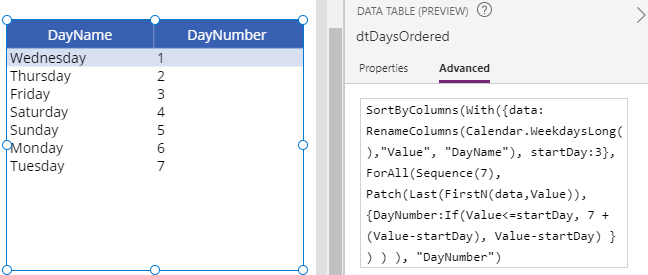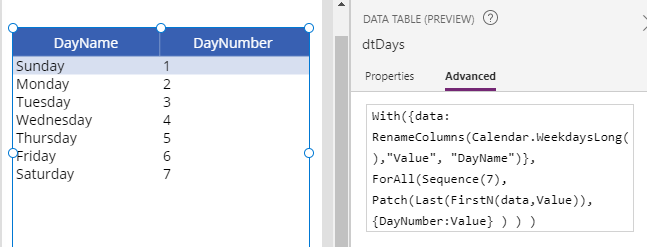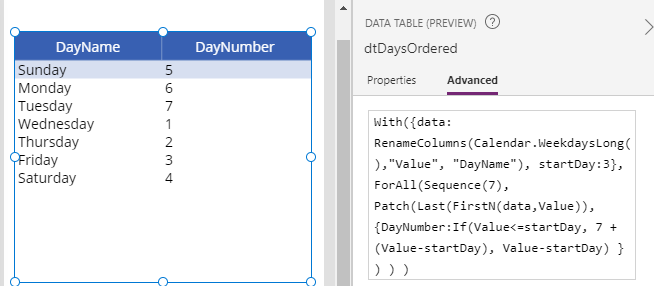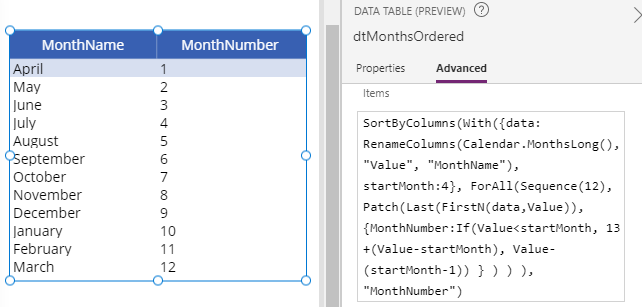Blog
Dates - How to get a numbered list of days or months, starting from a specified day or month
July 4. 2021
This post highlights a set of formulas that are typically used in scheduling type applications. A common use case scenario for these types of formula is for use in drop down controls for data entry, or for specifying date elements on search screens.
The starting point for much of this logic is the calendar function. This exposes the following properties to return tables of month and weekday names in long and short format: MonthsLong, MonthsShort, WeekdaysLong, WeekdaysShort.
1. Get a list of months and month numbers
To return a list of month and month numbers, we can use the following formula:
With({data: RenameColumns(Calendar.MonthsLong(),"Value", "MonthName")},
ForAll(Sequence(12),
Patch(Last(FirstN(data,Value)),
{MonthNumber:Value}
)
)
)

This formula utilises the row numbering pattern to generate the month numbers. There are more details about this technique in my post here.
2. Get a list of days and day numbers
We can adapt the above formula to return day and they numbers using the following formula:
With({data: RenameColumns(Calendar.WeekdaysLong(),"Value", "DayName")},
ForAll(Sequence(7),
Patch(Last(FirstN(data,Value)),
{DayNumber:Value}
)
)
)
3.Get week days, starting from a specified day
By default, the calendar function returns Sunday as day 1. If we want to specify a different day that corresponds to day 1, we can use the formula beneath. Here, startDay defines day one. In this example, we set this to 3 in order to specify that Wednesday should be day one.
With({data: RenameColumns(Calendar.WeekdaysLong(),"Value", "DayName"),
startDay:3},
ForAll(Sequence(7),
Patch(Last(FirstN(data,Value)),
{DayNumber:If(Value<=startDay, 7 +(Value-startDay), Value-startDay) }
)
)
)
Taking the source table from above, we can sort by DayNumber to return the output in ascending day number order.
SortByColumns(
With({data: RenameColumns(Calendar.WeekdaysLong(),"Value", "DayName"),
startDay:3},
ForAll(Sequence(7),
Patch(Last(FirstN(data,Value)),
{DayNumber:If(Value<=startDay, 7 +(Value-startDay), Value-startDay) }
)
)
),
"DayNumber"
)

4. Get 12 months, starting from a specified month
Let's suppose that the financial year for a company starts in April. We can use the following formula to number months, with month one starting in April.
SortByColumns(
With({data: RenameColumns(Calendar.MonthsLong(),"Value", "MonthName"),
startMonth:4},
ForAll(Sequence(12),
Patch(Last(FirstN(data,Value)),
{MonthNumber:If(Value<startMonth,
13 +(Value-startMonth),
Value-(startMonth-1)
)
}
)
)
),
"MonthNumber"
)
Conclusion
This post described formula to retrieve a list of days or months, and how to optionally specify the day or month to begin ordering.
- Categories:
- dates
Related posts
- Dates - How to convert a month name (eg January, Feburary, March) to month number (eg, 1, 2, 3)
- Dates - How to format date day numbers with suffix (st nd rd th)
- Formula - How to get the dates for the current week
- Dates - How to calculate UK tax weeks
- Dates - How to convert dates from MM DD YYYY to DD MM YYYY and vice versa
- Dates - How to detect overlapping times / scheduling conflicts
- Dates - How to display or convert Excel date serial numbers
- Dates - How to get the start date from week number
- Dates - How to check if a year is a leap year
- Dates - How to get the week number for a given date
- Dates - How to get the nth weekday for a month
- Dates - How to get the last weekday for a month
- Controls - How to display dates in a combo box
- Search - How to filter records by month and year using a delegable expression



